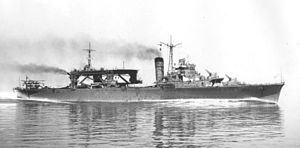 Chitose as a seaplane carrier
| |
| History | |
|---|---|
| Name | Chitose |
| Namesake | 千歳 (Thousand Years) |
| Builder | Kure Naval Arsenal, Kure, Japan |
| Laid down | 26 November 1934 |
| Launched | 29 November 1936 |
| Commissioned | 25 July 1938 |
| Notes | Converted from seaplane carrier to light aircraft carrier 26 January 1943–1 January 1944 |
| Recommissioned | 15 November 1943 |
| Reclassified | Light aircraft carrier 15 December 1943 |
| Reinstated | 1 January 1944 |
| Fate | Sunk 25 October 1944 |
| Stricken | 20 December 1944 |
| General characteristics | |
| Class and type | Chitose-class aircraft carrier |
| Displacement |
|
| Length | 192.5 m (631 ft 7 in) |
| Beam | 20.8 m (68 ft 3 in) |
| Draft | 7.5 m (24 ft 7 in) |
| Installed power | 56,000 shp (42,000 kW) |
| Propulsion |
|
| Speed | 28.9 kn (53.5 km/h; 33.3 mph) |
| Complement | 800 |
| Armament |
|
| Aircraft carried |
|
| Aviation facilities |
|
Chitose (千歳) was a warship of the Imperial Japanese Navy that served from 1938 to 1944, seeing service as a seaplane carrier and later as a light aircraft carrier during World War II. In her initial guise as a seaplane carrier, she first saw service during the Second Sino-Japanese War in 1938, and subsequently played a key role in the Imperial Japanese Navy's development of a network of seaplane bases on the islands of the Pacific Ocean. After the outbreak of World War II in the Pacific, she took part in the Philippines campaign, the Dutch East Indies campaign, the Battle of Midway, and the Guadalcanal campaign, during which she was damaged in the Battle of the Eastern Solomons and also saw service related to the Battle of Cape Esperance.
Chitose was converted into a light aircraft carrier during 1943, and subsequently took part in the Battle of the Philippine Sea and the Battle of Leyte Gulf. She was sunk in the Battle off Cape Engaño, one of several actions that made up the Battle of Leyte Gulf, on 25 October 1944.
Although it has been speculated that Chitose as a seaplane carrier also carried Type A midget submarines, only her sister ship Chiyoda had that capability.[1]
- ^ Tully, Athony (19 May 2014). "IJN Seaplane Carrier CHITOSE: Tabular Record of Movement". combinedfleet.com. Retrieved 11 December 2021.